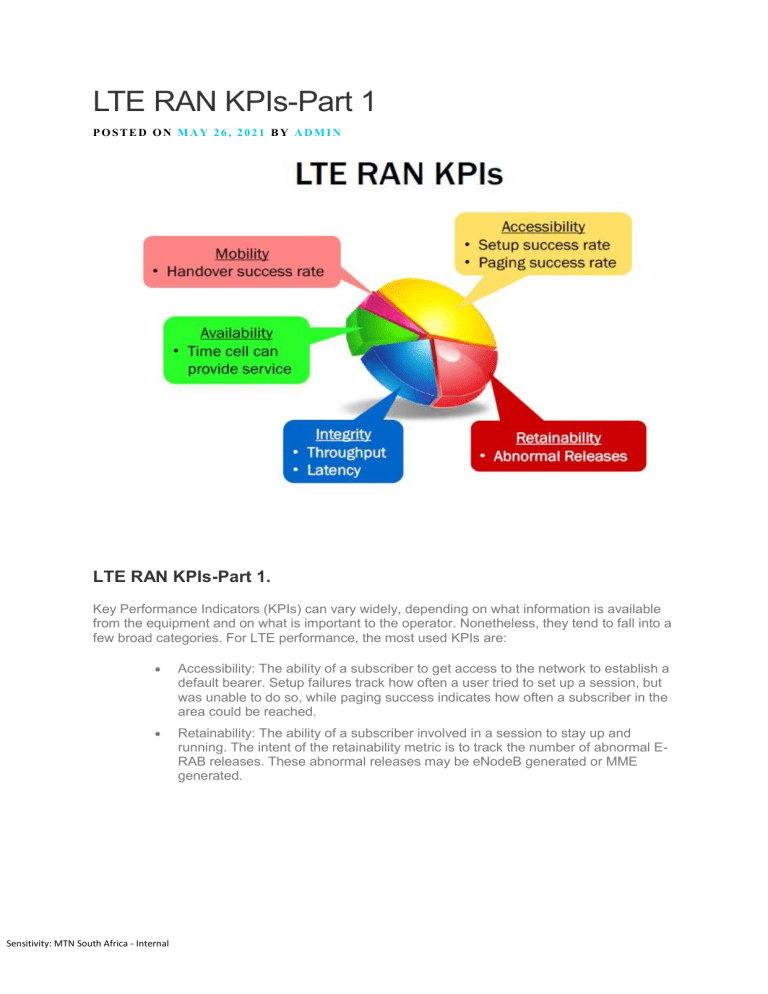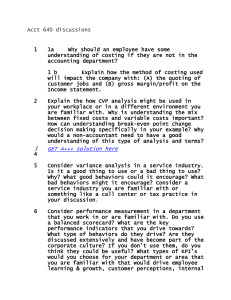LTE RAN KPIs: Accessibility, Retainability, Integrity, Mobility
advertisement

LTE RAN KPIs-Part 1 POSTED ON MAY 26, 2021 BY ADMIN LTE RAN KPIs-Part 1. Key Performance Indicators (KPIs) can vary widely, depending on what information is available from the equipment and on what is important to the operator. Nonetheless, they tend to fall into a few broad categories. For LTE performance, the most used KPIs are: Accessibility: The ability of a subscriber to get access to the network to establish a default bearer. Setup failures track how often a user tried to set up a session, but was unable to do so, while paging success indicates how often a subscriber in the area could be reached. Retainability: The ability of a subscriber involved in a session to stay up and running. The intent of the retainability metric is to track the number of abnormal ERAB releases. These abnormal releases may be eNodeB generated or MME generated. Sensitivity: MTN South Africa - Internal Integrity: This metric tracks the network’s ability to deliver IP packets to and from the end user. Integrity can be subdivided into two quality-based KPIs, which include throughput and latency. Mobility: Mobility simply measures the success rate of the handover preparation and execution phases. This includes intra-frequency handover, inter-frequency LTE handover, and inter-RAT handover. Availability: Availability is a KPI that measures the percentage of time that a cell can provide service to end users. Typically, both scheduled and unscheduled outages are included in the derivation of the metric. Step of RRC Connection Setup in LTE When the UE is powered up, it has to be RRC connected to be able to exchange data and signaling with the network. After the RRC connection, the Initial network attach allows to establish all the bearers to carry the data from the UE to the gateway. Sensitivity: MTN South Africa - Internal After the RRC connection, Signaling Radio Bearers (SRBs) are established. An SRB is a Radio Bearer that only carries the signaling: SRB1 carries the RRC signaling. SBR2 carries the NAS signaling, i.e. between the Core Network and the UE. During the Initial Attach: An MME is selected. The UE is authenticated. An IP address is allocated to the UE. S-GW and P-GW are selected. Bearers are established on the S1-U, S5/S8 and on the air interface. The RRC connection is reconfigured to allow user data traffic. At the end of the Initial Attach, the UE is able to reach external networks. The RRC Connection is basically made up of 2 steps: Contention Based Random Access. Exchange of Signaling to establish the connection. When a UE requests a connection, it has no dedicated resources to reach the eNodeB. It uses an uplink common channel which is able to manage the collision between 2 UEs requesting an access at the same time. QOS in LTE Part 1 Sensitivity: MTN South Africa - Internal POSTED ON MAY 30, 2021 BY ADMIN Spread the love QOS in LTE Part- 1 The LTE service provider will have a fixed amount of network resources. The goal of supporting QoS is to allocate these resources to different customers to meet their requirements while maximizing the revenues for the service provider. QoS is specified in terms of parameters like bandwidth, delay, jitter, and priority. The priority is important because the service provider may want to provide a better service to its Platinum customers over its regular customers. To effectively support QoS, a service provider identifies a network in which QoS can be defined, deployed, and enforced rapidly. Different services have different QoS requirements. For example, a VoIP service is a real-time service that cannot tolerate delay and jitter. It needs less but guaranteed bandwidth. Web browsing, on the other hand, needs more bandwidth but can tolerate delay and jitter. Sensitivity: MTN South Africa - Internal QOS in LTE The key QoS parameters associated with a service data flow are shown in this figure. 1. QoS Class Identifier (QCI): Defines the general class of the service. There are currently nine defined QCIs. A QCI is associated with a priority, specific delay, packet loss value and whether the service has a guaranteed bit rate. These characteristics are used by the EPS nodes (eNB, S-GW, P-GW) to guide them in deciding how a particular service data flow is to be processed. The QCI determines resource scheduling, rate shaping, and queue management. The QCI also maps to a specific DiffServ Code Point (DSCP) for IP forwarding through the GTP tunnels. At the eNB, the QCI is also used to determine RLC configuration. 2. Bearer Type: For GBR bearers, the GBR and MBR parameters are specified. For non-GBR bearers, the AMBR parameter is specified. 3. Allocation and Retention Priority (ARP): This parameter will be used in congestion situations when not all users and their services can be accommodated. The ARP will be used by the admission control function in the eNB. For example, a user may subscribe to a service such as real-time gaming. In the EPS, real-time gaming is defined as a specific class of service with a defined QCI value and associated parameter values for packet delay, etc. Realtime gaming is a GBR service and, therefore, will be assigned a guaranteed and maximum bit rate when the user subscribes. These bit rates may depend on the type of game in question. QOS Class Parameters The QoS attributes associated with the QoS Class Identifiers are shown in the table. Sensitivity: MTN South Africa - Internal Service data flows with QCIs of a GBR bearer type will be associated with a GBR parameter and an MBR parameter. The GBR parameter will be used in the admission control function in the eNB. Each QCI value has a priority that will be used by the EPS traffic nodes during congestion. If packet queues are close to overflow, then SDFs with lower priority (Priority 9 is the lowest) will have their packets discarded first. Note that IMS signaling packets have the highest priority, while QCI 9 is equivalent to best effort service. Prioritization of SDF aggregates of the same user will use this value and it should also be used in the prioritization across users. Although the PDB will play a greater role in the scheduling of one user’s traffic over another. The Packet Delay Budget (PDB) associated with a bearer will be one of the inputs used by the scheduler in the eNB to determine when to deliver packets of a service. The PDB values given in the table are a measure of the maximum time allowed for packet delivery from the P-GW to the UE. The eNB can assume that, on average, the delay from the P-GW to the eNB is 20 ms, and from this calculate the maximum over-the-air delay budget. The Packet Error Loss Rate (PELR) from the P-GW to the eNB is assumed to be zero in non-congestion situations. Therefore, the PLR in the table refers to noncongestion-related losses over the air. It is used in an eNB to help decide how to set up the radio bearer for a particular SDF (e.g., RLC AM or UM, modulation and coding parameters). QCIs 6, 8 and 9 may be used for differentiation on a service or subscriber basis. For example, QCI 8 can map to gold users, while QCI 9 is used for others. QCI 6 could be used to differentiate specific services separate from subscription classes. Note that the QoS parameter AMBR may be used to distinguish between two users or groups of users that are both assigned QCI 9 for their services. QOS Class in LTE 5G End to End KPI – Accessibility, Integrity and Utilization June 8, 2019Author5G, Cloud Computing, NR, Tech Fundas A Key Performance Indicator (KPI) is a measurable value that demonstrates how effectively a network is serving the user. In simple terms we can say KPIs describe the fitness level of a network, and this fitness level is measured with different matrix, e.g. when a doctor declare a Human being is fit and well, he measure his temperature, high blood pressure, high heart rate, blood sugar etc. similarly, network operates Sensitivity: MTN South Africa - Internal perform some measurement like network attach success rate, Average UL/DL data rate, Mobility success very famous for 4G/3Glegacy network to declare network as fit. 5G is quit new topic and as it will be covering too many uses cases, so we may expect new matrix to major the newtork KPIs and it is going to be a challenge for network operator while defining them. But if we see from the top, these KPI will under following categories. Accessibility Retainability Availability Mobility. Integrity Utilization 3GPP specification TS 28.554 has provided the definition for Accessibility, Integrity and Utilization. Accessibility KPI It is the probability that the user of a service after a request to a network receives the proceed-to-select signal within specified conditions. In 5G, successful registration to a network slice is the proceed-to-select signal to the UE. If users or subscribers cannot register to the network slice instance, they cannot access any network services in the network slice instance. This KPI is focusing on network view and following are the key matrix to measure accessibility KPI. Registered Subscribers of Network and Network Slice Instance through AMF: o Name: Registered Subscribers of Single Network Slice Instance through AMF Description: It describe the total number of subscribers that are registered to a network slice instance Logical Formula definition: This KPI is obtained by counting the subscribers in AMF that are registered to a network slice instance. Physical formula definition: o Measurement names used for the KPI: RegisteredAMFSubNbrMean KPI Object: 5GS KPI category: Accessibility Unit of the KPI: Integer Type of the KPI: Cumulative measurement Registered Subscribers of Network and Network Slice Instance through UDM o Sensitivity: MTN South Africa - Internal o Name: Registered Subscribers of Single Network Slice Instance through UDM Description:This KPI describe the total number of subscribers that are registered to a network slice instance. Logical Formula definition:This KPI is obtained by counting the subscribers in UDM that are registered to a network slice instance. Physical formula definition: Measurement names used for the KPI: RegisteredSubUDMNbrMean KPI Object: 5GS KPI category: Accessibility Unit of the KPI: Integer Type of the KPI: Cumulative measurement Registration success rate of one single network slice instance o Name: Registration success rate of one single network slice instance Description:This KPI describes the ratio of the number of successfully performed registration procedures to the number of attempted registration procedures for the AMF set which related to one single network slice instance and is used to evaluate accessibility provided by the end-to-end network slice instance and network performance. Logical Formula Definition: This KPI is obtained by successful registration procedures divided by attempted registration procedures. Physical Formula Definition: o Measurement names used for the KPI: AMF.5GSRegisAtt.Type, AMF.5GSRegisAttachSucc.Type KPI Object: 5GS KPI category: Accessibility Unit of the KPI: Interger Type of the KPI: Cumulative measurement Accessibilty KPI Use Case: The no.of registered subscribers of single network slice instance can be used to describe the amount of subscribers that are successfully registered, it can reflect the usage of network slice instance. It is also useful to evaluate accessibility performance provided by one single network slice instance which may trigger the life cycle management (scale up, scale down etc.) of the network slice. This kind of KPI is valuable especially when network functions (e.g. AMF) are shared between different network slice instances. This KPI is focusing on both network and user view. Sensitivity: MTN South Africa - Internal Integrity KPI Integrity is the property that data have not been altered in an unauthorized manner and Service integrity is the degree to which a service is provided without excessive impairments, once obtained. Downlink latency in gNB-DU o Name: Downlink latency for IP packets through gNB in split scenario Description:This KPI describes the gNB-DU part of the packet transmission latency experienced by an end-user. It is used to evaluate the gNB latency contribution to the total packet latency. Logical Formula Definition: This KPI is the average (arithmetic mean) of the time from reception of IP packet to gNB-DU until transmission of first part of that packet over the air interface, for a packet arriving when there is no previous data in queue for transmission to the UE Physical Formula Definition: o o Measurement names used for the KPI: DRB.RlcSduLatencyDl, DRB.RlcSduLatencyDl.QoS, KPI Object: NG-RAN KPI category: Integrity Unit of the KPI:Time interval (millisecond) Type of the KPI:MEAN gNB-DU Latency KPI User Case: The end-to-end latency is an important performance parameter for operating 5G network. In some scenarios (e.g. uRLLC), if end-to-end latency is insufficient, the 5G network customer cannot obtain guaranteed network performance provided by the network operator. So it is necessary to define end-to-end latency of network related measurement to evaluate whether the end-to-end latency that network customer requested has been satisfied. A procedure is invoked by network management system and is used: o To update the CSMF/NSMF with the end-to-end latency parameter for monitoring; To inform the network customer/network operator the end-to-end latency; To make CSMF/NSMF aware if the end-to-end latency can meet network customer’s service requirement. If high end-to-end latency are measured, it is also of benefit to pinpoint where in the chain from application to UE that the latency occurs. Upstream Throughput for Network and Network Slice Instance o Sensitivity: MTN South Africa - Internal Name: Upstream throughput for network and network slice instance Description:This KPI describes the upstream throughput of one single network slice instance by computing the packet size for each successfully transmitted UL IP packet through the network slice instance during each observing granularity period and is used to evaluate integrity performance of the end-to-end network slice instance. Logical Formula Definition: This KPI is obtained by upstream throughput provided by N3 interface from NG-RAN to UPF which is related to the single network slice instance. Physical Formula Definition: o Measurement names used for the KPI:GTP.InDataOctN3UPF KPI Object: 5GS KPI category: Integrity Unit of the KPI:Kbit/s Type of the KPI: Cumulative measurement Downstream Throughput for Single Network Slice Instance o Name: Downstream throughput for network and network slice instance. Description:This KPI describes the downstream throughput of one single network slice instance by computing the packet size for each successfully transmitted DL IP packet through the network slice instance during each observing granularity period and is used to evaluate integrity performance of the end-to-end network slice instance. Logical Formula Definition: This KPI is obtained by downstream throughput provided by N3 interface from NG-RAN to UPF which is related to the single network slice instance. Physical Formula Definition: o Measurement names used for the KPI:GTP.OutDataOctN3UPF KPI Object: 5GS KPI category: Integrity Unit of the KPI: Kbit/s Type of the KPI: Cumulative measurement Upstream Throughput at N3 interface o Sensitivity: MTN South Africa - Internal Name: Upstream GTP data throughput at N3 interface Description: This KPI describes the total number of octets of all incoming GTP data packets on the N3 interface (measured at UPF) which have been generated by the GTP-U protocol entity on the N3 interface, during a granularity period. This KPI is used to evaluate upstream GTP throughput integrity performance at the N3 interface. Logical Formula Definition: This KPI is obtained by measuring the GTP data upstream throughput provided by N3 interface from NGRAN to UPF, during the granularity period. Physical Formula Definition: o Measurement names used for the KPI:GTP.InDataOctN3UPF KPI Object: 5GS KPI category: Integrity Unit of the KPI: Kbit/s Type of the KPI: MEAN Downstream Throughput at N3 interface o Name: Downstream GTP data throughput at N3 interface. Description:This KPI describes the total number of octets of all downstream GTP data packets on the N3 interface (transmitted downstream from UPF) which have been generated by the GTP-U protocol entity on the N3 interface, during a granularity period. This KPI is used to evaluate integrity performance at N3 interface. Logical Formula Definition: This KPI is obtained by measuring the GTP data downstream throughput provided by N3 interface from UPF to NG-RAN, during the granularity period. Physical Formula Definition: o Measurement names used for the KPI:GTP.OutDataOctN3UPF KPI Object: 5GS KPI category: Integrity Unit of the KPI: Kbit/s Type of the KPI: MEAN Throughput KPI Use Case: Measuring throughput is useful to evaluate system load of end to end network slice. If the throughput of the specific network slice instance cannot meet the performance requirement, some actions need to be performed to the network slice instance e.g. reconfiguration, capacity relocation. So it is necessary to define the IP throughput for one single network slice instance. This KPI is focusing on network and user view. RAN UE Throughput o Sensitivity: MTN South Africa - Internal Name: RAN UE Throughput. Description: A KPI that shows how NG-RAN impacts the service quality provided to an end-user Logical Formula Definition:Payload data volume on RLC level per elapsed time unit on the air interface, for transfers restricted by the air interface. Physical Formula Definition: o o o Measurement names used for the KPI:DRB.UEThpDl, DRB.UEThpUl, DRB.UEThpDl.QoS, DRB.UEThpUl.QoS KPI Object: NG-RAN KPI category: Integrity Unit of the KPI: Kbit/s Type of the KPI: MEAN UE Throughput KPI Use Case:The UE perceived throughput in NG-RAN is an important performance parameter for operating 5G network. If the UE throughput of the NR cell cannot meet the performance requirement, some actions need to be performed to the network, e.g. reconfiguration or capacity increase. So it is necessary to define UE throughput KPI to evaluate whether the endusers are satisfied. The KPI covers volume large enough to make the throughput measurement relevant, i.e. excluding data volume of the last or only slot. The UE throughput KPI covers also “NR option 3” scenarios. Then the gNB is “connected” towards the EPC, and not towards 5GC. It is proposed to allow the KPI separated based on mapped 5QI (or for QCI in case of NR option 3). When network slicing is supported by the NG-RAN, multiple Network Slice Instances may be supported. The UL and DL UE throughput for each NSI (NSI) is then of importance to the operator to pinpoint a specific performance problem. Utilization KPI Mean number of PDU sessions of network and network Slice Instance o Name: Mean number of PDU sessions of Single Network Slice Instance. Description: This KPI describes the mean number of PDU sessions that are successfully established in a network slice instance. Logical Formula Definition: This KPI is obtained by successful PDU session establishment procedures of SMFs which is related to the network slice instance. Physical Formula Definition: o Measurement names used for the KPI: PDUSessionNum KPI Object: 5GS Sensitivity: MTN South Africa - Internal KPI category: Utilization Unit of the KPI: Erlang Type of the KPI: MEAN o KPI Use Case: It is necessary to evaluate the mean PDU session number in the network slice instance to indicate system load level. For example, if the mean value of the PDU sessions is high, maybe the system capacity should be increased. This KPI is focusing on network view. Virtualised Resource Utilization of Network Slice Instance o Name: Virtualised resource utilization of single network slice instance Description: This KPI describes utilization of virtualization resource (e.g. processor, memory, disk) that are allocated to a network slice instance. Logical Formula Definition: This KPI is obtained by the usage of virtualization resource (e.g. processor, memory, disk) divided by the system capacity that allocated to the network slice instance. Physical Formula Definition: o o Sensitivity: MTN South Africa - Internal Measurement names used for the KPI: MeanProcessorUsage, MeanMemoryUsage, MeanDiskUsage, System capacity indicates amount of virtualised resource which allocated to the network slice instance. KPI Object: 5GS KPI category: Utilization Unit of the KPI:Percentage Type of the KPI:Ratio Utilization KPI Use Case: It is necessary to evaluate the current utilization of virtualised resources (e.g. memory and storage utilization) that a network slice instance is occupied. If the utilization is larger or smaller than the threshold, maybe some scale in/out operations will be made by the management system. This KPI is focusing on network and user view.




